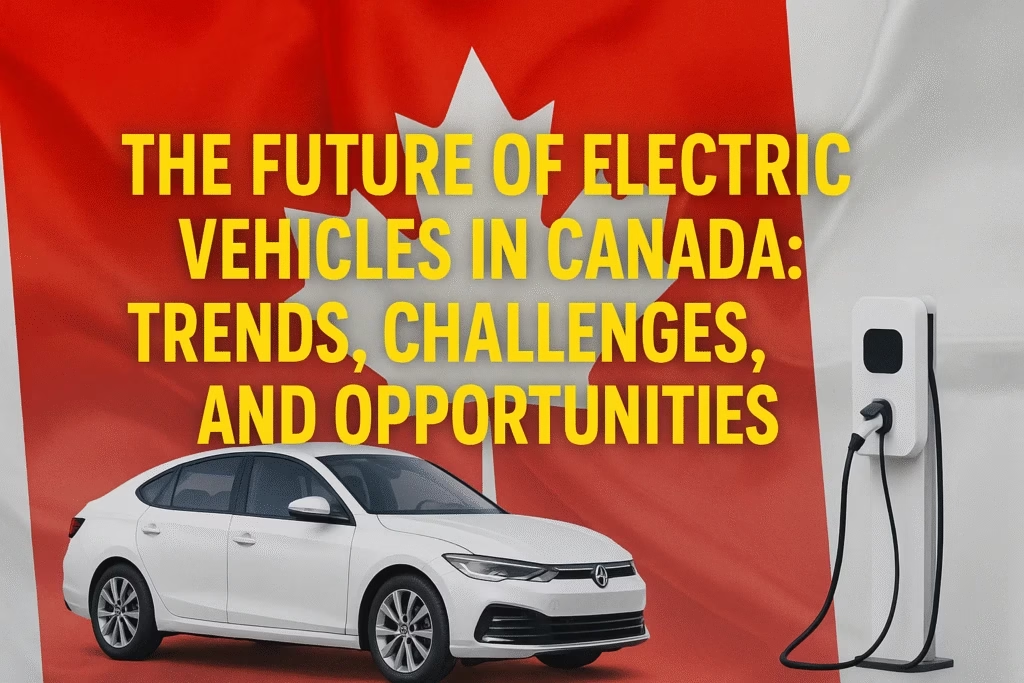As the world transitions toward cleaner transportation, Canada is emerging as a key player in the electric vehicle (EV) revolution. From federal incentives and infrastructure development to growing consumer interest and manufacturer investments, the momentum behind electric vehicles is stronger than ever.
In this article, we’ll explore the current landscape of EV adoption in Canada, examine government policies, highlight emerging trends, and analyze the challenges and opportunities that lie ahead.
Why Electric Vehicles Matter in Canada
Transportation accounts for nearly 25% of Canada’s greenhouse gas (GHG) emissions, making it one of the biggest contributors to climate change. Transitioning from gas-powered cars to electric vehicles is not just about reducing emissions—it’s about reshaping the future of mobility.

Canada’s vast geography, diverse climate, and dependence on imported oil make it an ideal candidate for a shift toward home-grown, renewable-powered transportation.
Current EV Adoption in Canada
As of 2024, over 300,000 electric vehicles are on Canadian roads, and that number is rising quickly. Sales of battery electric vehicles (BEVs) and plug-in hybrid electric vehicles (PHEVs) increased by over 40% year-over-year, with provinces like British Columbia, Quebec, and Ontario leading the way.
Some key factors driving this growth:
- Greater availability of EV models from top brands like Tesla, Hyundai, Ford, and GM.
- Better affordability due to government incentives.
- Increased public awareness about climate change and energy efficiency.
Federal and Provincial Incentives Driving EV Growth
One of the key reasons behind the rise in EV adoption in Canada is the availability of financial incentives and rebates for buyers.
- Federal iZEV Program: Offers up to $5,000 rebate for eligible EV purchases.
- Provincial Incentives: In British Columbia, buyers can receive an additional $4,000 through the CleanBC Go Electric program. Quebec provides up to $7,000 in provincial rebates.
Additionally, the Canadian government plans to mandate that all new light-duty cars and passenger trucks sold by 2035 be zero-emission vehicles (ZEVs). This long-term policy reinforces Canada’s commitment to a cleaner transport system, supporting E-E-A-T principles like trustworthiness and long-term expertise in policymaking.
Charging Infrastructure: A Work in Progress
One of the major barriers to EV adoption in Canada has been charging infrastructure. The good news? It’s improving fast.
The federal government is investing over $1.7 billion to build a coast-to-coast network of public EV chargers in urban and rural areas. As of 2024, there are over 25,000 public charging stations, with thousands more in development.
Private companies like Petro-Canada, Tesla, and FLO are also expanding their networks. Fast-charging stations, which can charge most EVs up to 80% in under 30 minutes, are becoming more common along major highways and in urban centres.
Still, rural communities and colder regions face challenges in accessing reliable charging. Addressing these gaps will be essential to ensure all Canadians benefit from the EV transition.
Canada’s Role in EV Manufacturing and Battery Supply Chain
Canada is not just a consumer of electric vehicles—it’s becoming a major player in the EV manufacturing and battery supply chain.
With rich deposits of lithium, nickel, cobalt, and graphite, Canada holds many of the minerals essential for battery production. The federal and provincial governments are actively supporting battery gigafactories and EV manufacturing plants through partnerships with major automakers.
Some highlights:
- Stellantis and LG Energy Solution are building a $5 billion EV battery plant in Windsor, Ontario.
- Volkswagen announced its first North American battery gigafactory in St. Thomas, Ontario.
- Ford Motor Company is investing in EV assembly and battery production in Oakville.
Challenges Still Facing EV Adoption
- High upfront costs: Even with incentives, EVs are still more expensive than comparable gas-powered vehicles.
- Range anxiety: In remote regions, limited charging options make consumers hesitant.
- Harsh climate conditions: Cold weather can reduce battery efficiency and range.
- Lack of used EV market: Many Canadians depend on the used vehicle market, which still lacks EV options.
The Future Roadmap: What to Expect by 2030
By 2030, Canada aims to have millions of electric vehicles on the road, powered by a fully integrated, renewable-powered grid. Here’s what to expect:
- Wider EV availability in all vehicle classes, including SUVs, trucks, and commercial.
- Smarter charging networks that use AI to manage electricity demand and reduce peak load pressure.
- EV-friendly urban planning, with charging ports in condos, apartments, and public spaces.
- Advanced battery recycling plants to support a circular economy.
Canada’s clean energy goals and advanced R&D ecosystem will help accelerate this transformation.
How Canadians Can Get Involved
You don’t need to buy a Tesla to support the EV movement. Here are simple steps to participate:
- Consider an EV or hybrid when it’s time to upgrade your vehicle.
- Use public transport and car-share services with electric fleets.
- Take advantage of government rebates for home EV chargers.
- Talk to your city councillor about supporting local EV infrastructure.